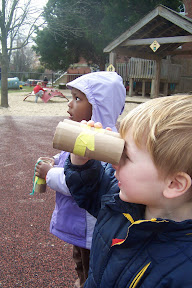Recording observations and collecting data about birds
By Peggy Ashbrook
Posted on 2011-03-02
 Birds are wild animals that children are quite likely to see and recognize. They live in the city and in the country and in between, all over the world. Why not begin talking about the birds that your students see near school, and have them name all the colors they see? To attract birds for closer observation teachers sometimes put up a feeder where it can be seen from a window for easy viewing and counting. Read about making observations and collecting data in the March 2011 Early Years column in Science and Children.
Birds are wild animals that children are quite likely to see and recognize. They live in the city and in the country and in between, all over the world. Why not begin talking about the birds that your students see near school, and have them name all the colors they see? To attract birds for closer observation teachers sometimes put up a feeder where it can be seen from a window for easy viewing and counting. Read about making observations and collecting data in the March 2011 Early Years column in Science and Children.
Here are some of my favorite early childhood resources for learning about birds and bird behavior.
Articles with ideas for classroom activities
Search Science and Children for “bird” to find almost 20 articles on science learning about birds (NSTA membership required).
 STEM Comes to Preschool by Sally Moomaw and Jaumall A. Davis. Young Children. September 2010 Vol 65 (5): 12-18. The article relates how they used toy Audubon birds (plush replicas of real birds which have a micochip inside that plays a recorded authentic song of the species) in an inclusive preschool classroom to teach patterning.
STEM Comes to Preschool by Sally Moomaw and Jaumall A. Davis. Young Children. September 2010 Vol 65 (5): 12-18. The article relates how they used toy Audubon birds (plush replicas of real birds which have a micochip inside that plays a recorded authentic song of the species) in an inclusive preschool classroom to teach patterning.
Field guides or identification books. No single book fits all needs. Every “birder” has their favorite, but take a look at these two to begin with.
Birds, A Golden Guide by Ira N. Gabrielson, Herbert S. Zim, Chandler S. Robbins (Ed.), illustrated by James Gordon Irving. 2001. St. New York, NY: Martin’s Press. An inexpensive guide for beginning birdwatchers.
Kaufman Field Guide to Birds of North America. Kenn Kaufman. 2005. New York, NY: Houghton Mifflin. A field guide with digitally enhanced photographs and pointers (leader lines) to field marks (distinguishing markings or aspects to note that aid identification), this book is fun for children to use for identification purposes, to browse through, or to read about a particular species.
Trade books
A Place for Birds by Melissa Stewart, illustrated by Higgins Bond. 2009. Atlanta, GA: Peachtree. This book introduces 24 species, includes details in sidebars and describes solutions for problems people create for birds.
Backyard Birds of Winter by Carol Lerner. 1994. New York, NY: HarperCollins. This book targets birds of colder climates and includes feeder information.
Counting Is for the Birds by Frank Mazzola Jr. 1997. Watertown, MA: Charlesbridge. Birds flock to the feeder by one then two and so on, up to 20 (you will have to add the count of zero). Have your students count each species and look for non-birds, a squirrel and cat.
Feathers for Lunch by Lois Elhert. 1996. San Diego, CA: Harcourt. Twelve birds (illustrated with accuracy in Elhert’s appealing cut paper collage style) escape the cat’s pounce. Have your children match birds in this book to birds in a non-fiction bird identification book, and predict the ending of the book. Depicts the real danger to songbirds of allowing pet cats outside.
Fly High, Fly Low by Don Freeman. 2004. New York, NY: Penguin. Now in a 50th anniversary edition, this classic story follows a pair of nesting pigeons (Rock doves Sid and Midge) in San Francisco. Pair this book with the Project PigeonWatch poster (free download).
How the Robin Got Its Red Breast: A Legend of the Sechelt People by Donna Joe, Sechelt Nation, illustrated by Charlie Craigan. 1993. Roberts Creek, BC: Nightwood Editions. Compelling black-and-white illustrations relate the Sechelt legend of how the robin got its colors. Traditional tales often teach about the natural world while serving as guides for proper conduct.
Internet
BirdWatching online magazine (formerly Birder’s World), see the bird photo of the week.
Cornell Lab of Ornithology. Download a free poster, listen to bird calls and songs, read the All About Birds page “Birding 1-2-3: How to Identify Birds” and see the “PigeonWatch” section for information about these common birds. Read about the Feeder Watch Project to learn how to count birds at your feeder and submit a tally sheet to participate in this citizen science endeavor.
Exploring Nature. Look for your local birds on this natural history website with a free database describing many North American birds.
Monterey Bay Aquarium’s Sandy Shore & Aviary Web Cam. Look for oystercatchers, curlews and other birds using the webcam in this California aviary, or play bird bingo.
 Do you, or does your class, have a favorite book about birds?
Do you, or does your class, have a favorite book about birds?
Peggy
Disclaimer: The views expressed in this blog post are those of the author(s) and do not necessarily reflect the official position of the National Science Teaching Association (NSTA).


